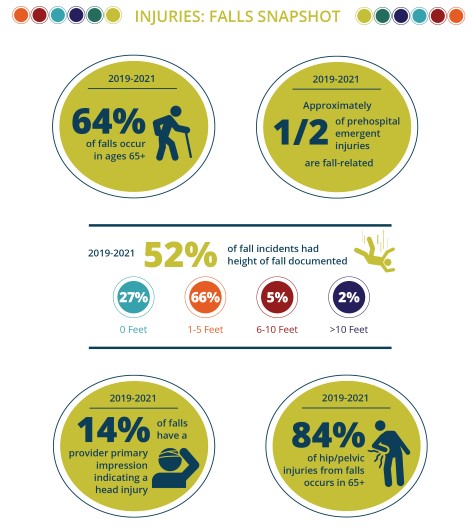ADVERTISEMENT
Falls Are a Big Problem—Here’s What to Do About Them

A report that analyzed 24 million prehospital records found injuries accounted for nearly 20% of all emergent incidents requiring emergency medical services (EMS), with approximately 50% of injuries categorized as falls. The report, published as part of the ImageTrend Collaborate research program, also found trends associated with where fall-related injuries were more common and who may be more susceptible.
Looking at deidentified data from January 1, 2019, to December 31, 2021, the report found 64% of fall-related injuries involved those 65 years or older, followed by 17% in adults between 50–64. Pediatric patients made up only 5% of emergent fall incidents.
Of all 9-1-1 responses to fall-related incidents, more than 75% required transport. Two-thirds of all emergent falls for which the height of the fall was documented occurred from 1–5 feet, which could be from steps, stairs, or furniture. Nearly another third occurred from level surfaces, indicating slips or trips. The report also showed falls were more prevalent in winter months and in the Midwest and Northeast regions of the United States, where slippery conditions are more frequent.

Diving deeper into the elderly population, 65% of falls in the age group occurred in private residences. Additional results found that 84% of hip/pelvic-related fall injuries occur in the elderly population. The report added that even though falls in the elderly are common, they are very preventable with appropriate intervention and community risk reduction programs.1,2
EMS organizations considering such programs can start with the National Center for Injury Prevention and Control document “Preventing Falls: A Guide to Implementing Effective Community-Based Fall Prevention Programs.” These can be implemented through community paramedicine programs and in partnership with appropriate community resources.
Falls are a normal part of aging, and the CDC recommends speaking up, staying active, and making residences safe to extend independence for the elderly. Those of us in public health, EMS, and the fire service can encourage open dialogue about fall risk, potential health consequences, and being able to speak openly with one’s doctor about past falls or dizziness symptoms. We can promote leg-strengthening and balance exercises in our communities and help those who are at risk keep their homes safe. We can use data to map hotspots of past fall incidents and deploy resources to evaluate trip hazards, stability aids, and lighting that might be used effectively to keep people steady on their feet.
Not only is this an opportunity to incorporate risk reduction into training, it’s also an opportunity to work with local public health departments to identify at-risk individuals. Establishing a community paramedicine program focused on falls can help prevent them and ultimately reduce the long-term burden on EMS through prevention efforts.
Epidemiologist Morgan K. Anderson, the lead author of the report, says, “As a top-3 reason for 9-1-1 response, it’s important to bring awareness to these types of injuries. Fall-related injuries is a new category added to this year’s annual Collaborate report looking at trends across various topics in the prehospital setting.”
The report also looked at EMS response related to COVID-19, influenza, traffic-related incidents, behavioral health, alcohol, and suspected substance use, and further dissected the findings above to deliver insights to help make data-driven decisions. Download a copy of the report for all its findings.
References
1. Centers for Disease Control and Prevention. Older Adult Fall Prevention. Accessed June 24, 2022. www.cdc.gov./falls/index.html
2. National Center for Injury Prevention and Control. Preventing Falls: A Guide to Implementing Effective Community-based Fall Prevention Programs, 2nd ed. Centers for Disease Control and Prevention; 2015.
Caelan Barnhart works at ImageTrend with the goal of sharing the emergency medical services industry’s story. He has a bachelor’s degree in journalism from the University of Florida, where he gained newsroom experience writing for local stations.










